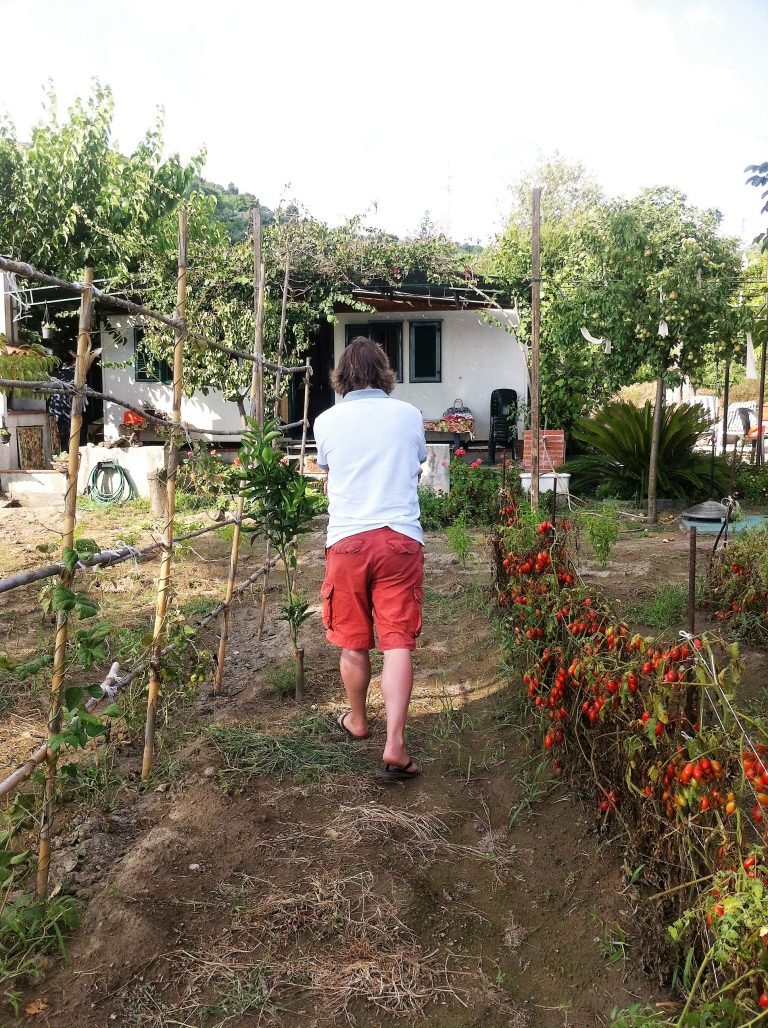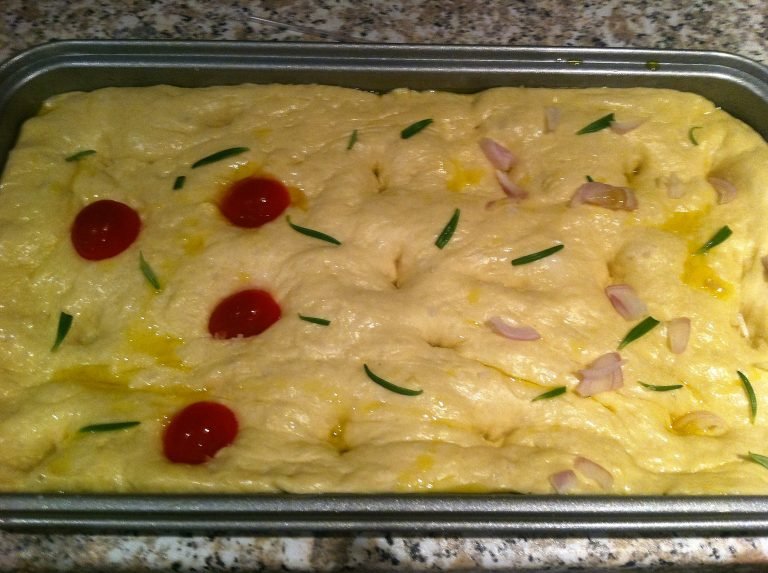
Nothing beats a good home-made focaccia. It was always on the table when sharing a meal at my Italian home with my family. It is relatively easy to make and it goes well with everything (cheese, tomatoes, cured meats, dips). Simply addictive! I can still remember George’s ecstatic expression when I first made focaccia for him.
It was November 2014, and it was that night that I pulled myself together and decided to start testing 150 Neapolitan and southern Italian recipes.
Also, it was a cold winter night and I needed my fair and deserved share of carbs. And nope, any old loaf of bread or shop-bought focaccia just would not do it.
That night as we sat at the dinner table together, we looked into each other eyes and said: we are going to do this. And then scoffed the focaccia in less than 5 minutes. It was a very short dinner!

What inspired me to make the focaccia that night was a family event we had attended a few months earlier. We were at my aunt’s Carla farm in Pozzuoli for a small family gathering. And the memories of hot slices of focaccia with rosemary and cherry tomatoes were still vivid in my mind.

Cooked in the wood-fired oven and eaten warm with some cheese and divine mortazza (mortadella) as aperitivo, the focaccia went down a treat as we all cheerfully got on with the prep for the rest of the meal. What to say? Heaven.

Perfect served as an antipasto with un tagliere di affettati (ham, salami and good solid slices of provolone) or just to enjoy on its own. The focaccia has its own soul and reason for existence. Long live the focaccia!
Ingredients for focaccia
Serves 6
- 7g active dried yeast
- 1 teaspoon sugar
- 300ml warm water (125ml first and then 175ml)
- 500g bread flour (00 ideally) or all-purpose flour
- 1 teaspoon fine salt
- 4 tablespoons extra-virgin olive oil (60ml)
- 1 tablespoon coarse sea salt
Extra
- 8 cherry tomatoes, washed and halved
- 1 big sprig of rosemary, washed and dried and leaves removed from the stem (chop the leaves finely if preferred)
In a medium-sized bowl add 125 ml of warm water, the yeast and the sugar and stir until everything is dissolved. Leave to rest for 10 minutes, until it gets all bubbly.
Meanwhile, sift the flour into a separate, larger bowl.
Create a well and add the previously prepared yeast compost in the middle, as well as two tablespoons of extra-virgin oil. Start mixing the compost in the middle with your hands or a fork while slowly incorporating some of the flour on the edges. Do so for a couple of minutes until the compost is smooth and lump-free.
This is a key step. You cannot have any lumps as when you add extra water and flour, it will only get worse. So spend enough time making sure it is a smooth mixture.

Add the rest of the warm water (175ml) to a jug, add a teaspoon of fine salt and stir well.
Pour the rest of the water into the middle of the flour mixture. Mix with your hands and add gradually the rest of the flour until it has been incorporated and you get a roughly shaped ball. During this stage you need to make sure that there are no lumps. The smoother the better.
Move the dough to a surface lightly sprinkled with flour and let the fun part begin: the kneading!
Press the dough down with your knuckles and spread it. Take the far end of the dough and fold it a short distance towards you. Push it away with the heel of your hand. Repeat this operation for about 10 minutes until you obtain a dough that is smooth and elastic and springs back when you try to flatten it with your fingers.
Line a large bowl with oil, place the dough in it and cover with cling film. Store in a dry place for 2 hours, or until the dough doubles in size. Rising depends on the temperature. During winter it might take a little bit longer than during a warmer season (unless you live in London when it might still be cold in summer…).
When the dough is ready take it out of the bowl and knead it for a minute.
Preheat the oven to 220˚C (200˚C fan).
Line the tin (18x32cm) with a teaspoon of oil, distributing it evenly across the whole surface.
Place the dough in the middle of the tin. Spread the dough with your fingers 1 cm deep across the whole tin. Dimple the surface with your fingertips. Add the rest of the extra virgin olive oil and distribute evenly with your fingers. Sprinkle the coarse sea salt.
At this stage you can add chopped cherry tomatoes in each of the semi holes you created across the whole surface, and some rosemary.

Bake the focaccia in the oven at 220˚C (200˚C fan) for 20 minutes, until it gets golden brown.
Serve it hot or warm, with any cheese or cured meats you fancy. Or just eat it as it is.
There really is nothing nicer than treating friends or family to a nice home-made focaccia. Yes, I know. There are amazing delis and big supermarket chains with their own bakeries that make a mean focaccia – but they can’t beat the one you make at home. As with any other home-made food: it just can’t be beaten!
